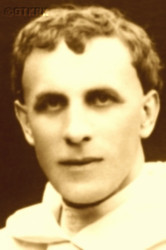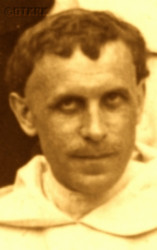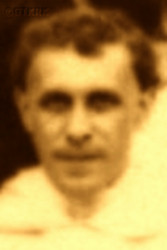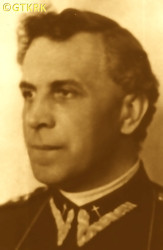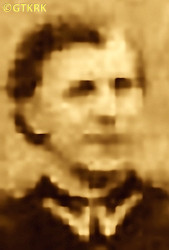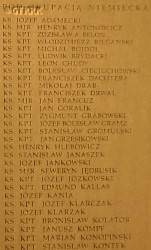Roman Catholic
St Sigismund parish
05-507 Słomczyn
85 Wiślana Str.
Konstancin deanery
Warsaw archdiocese, Poland
full list:
displayClick to display full list

searchClick to search full list by categories
wyświetlKliknij by wyświetlić pełną listę po polsku

szukajKliknij by przeszukać listę wg kategorii po polsku

Martyrology of the clergy — Poland
XX century (1914 – 1989)
personal data
surname
JĘDRYSIK
forename(s)
Severin (pl. Seweryn)
religious forename(s)
Vincent Mary (pl. Wincenty Maria)
function
religious cleric
creed
Latin (Roman Catholic) Church RCmore on
en.wikipedia.org
[access: 2014.09.21]
congregation
Order of Preachers OPmore on
en.wikipedia.org
[access: 2013.07.06]
(i.e. Dominican Order, Dominicans)
diocese / province
St Hyacinth Polish Province
St Hyacinth Galicia Province OP
RC Military Ordinariate of Polandmore on
en.wikipedia.org
[access: 2014.12.20]
honorary titles
„Cross of Independence”more on
en.wikipedia.org
[access: 2019.02.02]
(16.09.1931)
Gold „Cross of Merit”more on
en.wikipedia.org
[access: 2019.04.16]
(15.09.1938)
Commemorative Medal for War of 1918–21more on
pl.wikipedia.org
[access: 2019.10.13]
Cross on the Silesian Ribbon of Valor and Merit
„Star of Upper Silesia” badge
date and place
of death
05.09.1942

KL Dachauconcentration camp
today: Dachau, Upper Bavaria reg., Bavaria state, Germany
more on
en.wikipedia.org
[access: 2016.05.30]
details of death
After the outbreak of the World War I 1914‐1918, as a student in Vienna but a subject of the German Emperor, drafted into German Imperial Army. Left Vienna and in Nowy Targ, under an assumed Jacentowicz name, joined 1st Brigade of the Polish Legions — 6th Battalion 1st Infantry Regiment — of the Austro–Hungarian Imperial Army instead. Took part in battles with Russians on Nida river (03‐04.1915), Konary (16‐23.05.1915), on Styr and Stochod rivers (11.1915‐07.1916), in Kostiuchnówka battle (04‐07.1916), when the Legions stopped the Russian Brusilov offensive in their sector, preventing the front from being broken through. In the summer of 1916 withdrawn with Brigade from the Russian front. From 09.07.1917, when refused — as most of the soldiers of 1st Brigade — to take an oath of allegiance to the German Emperor, in hiding in eastern Lesser Poland for a year. There lived to see the end of the war and the creation of the Polish state.
On 05.02.1919 joined 7th Riflemen Battalion (later 1st Bytom Riflemen Regiment). After completing School of Officers in Warsaw in 07.1920 sent back to Upper Silesia, to his family region, the–then awaiting plebiscite to decide its fate. Took part in the 2nd Silesian Uprising (19‐25.08.1920). Next joined Polish clandestine military organisation Physical Education Central CWF (successor of Polish Military Organisation for Upper Silesia), from 15.01.1921 renamed as Plebiscite Defense Command DOP. From 03.1921 commander of DOP in Strzelce county, under nom‐de‐guerre „Wallenstein”. During 3rd Silesian Uprising in 05.1921 managed to take control of most of the Strzelce county, including his place of birth, Kamień Śląski. Took part in Polish defense efforts in Góra Świętej Anny (21‐30.05.1921).
After the end of the war of Polish borders verified in the rank of reserve infantry lieutenant (with seniority from 01.06.1919).
In 1936, called up again to active service in the Polish Army, in the rank of chaplain (with seniority from 01.05.1936).
After German and Russian invasion of Poland in 09.1939 and start of the World War II participated in defense war of 1939 against Germans — with the 20th Infantry Division of the Polish Armed Forces, part of „Modlin” Army — in the battle of Mława among others.
After 13‐14.09.1939 commander of Pastoral Services „North” Defence Line Command, part of Warsaw–East defense line, defending Warsaw–Praga region.
From the mayor of Warsaw, Stefan Starzyński, awarded the „Meritorious Defender of the Capital” commemorative card.
After Warsaw fall on 28.09.1939 interned by the Germans as POW.
On 08.10.1939 in Radziwiłłów n. Skierniewice celebrated his last field Holy Mass to his soldiers, prior to transport to POW camps.
Next interned in POW camps, such Oflag IV A Hohnstein and Oflag IX C Rotenburg an der Fulda.
From there on 18.04.1940 as POW prisoner, in contravention of Hague conventions, transported to KL Buchenwald concentration camp, and finally on 06‐07.07.1942 to KL Dachau concentration camp where was murdered — after the camp was notified by German Germ. Geheime Staatspolizei (Eng. Secret State Police), i.e. Gestapo, from Pszczyna about his activities in free Poland, especially his contribution in battles in Upper Silesia.
According to the death certificate, prepared in KL Dachau, the „honest” otherwise German „medical doctors” and formalists — and at the same time, unrivaled fairy tale spinners — noted that the cause of death was Germ. „Versagen von Herz und Kreislauf, bei Darmkatarrch” (Eng. „Heart and circulatory failure, due to intestinal catarrh”).
alt. details of death
According to other sources after volunteering and joining 7th Riflemen Battalion (later 1st Bytom Riflemen Regiment) — formally set up on 04.02.1919 in Częstochowa but formed on 15.05.1919 — prob. took part in border skirmishes with Germans, among others n. Wieruszów, and next in Polish–Russian war of 1920.
Prob. sent with his unit to Adutiškis on the Lithuanian front and there on 02.06.1919 took part in Rybczany battle, where Russian offensive of gen. Tuchaczewski was halted for a short time.
Then (or after Warsaw battle of 08.1920) was to return to his home Silesia.
prisoner camp's numbers
31211Click to display source page (KL DachauClick to display the description), 599Click to display source page (KL BuchenwaldClick to display the description)
cause of death
murder
perpetrators
Germans
sites and events
KL DachauClick to display the description, KL BuchenwaldClick to display the description, Oflag IX C Rotenburg an der FuldaClick to display the description, Oflag IV A HohnsteinClick to display the description, Ribbentrop‐MolotovClick to display the description, Pius XI's encyclicalsClick to display the description, Polish‐Russian war of 1919‐1921Click to display the description, Silesian UprisingsClick to display the description
date and place
of birth
25.08.1893

Kamień Śląskitoday: Gogolin gm., Krapkowice pov., Opole voiv., Poland
more on
en.wikipedia.org
[access: 2021.04.02]
alt. dates and places
of birth
26.08.1893
parents
JĘDRYSIK Valentine
🞲 ?, ? — 🕆 ?, ?

Mary
🞲 ?, ? — 🕆 ?, ?
religious vows
26.10.1922 (temporary)
presbyter (holy orders)
ordination
29.06.1927

Lvivtoday: Lviv urban hrom., Lviv rai., Lviv obl., Ukraine
more on
en.wikipedia.org
[access: 2022.01.16]
positions held
1936 – 1939
parish priest — Slonimtoday: Slonim dist., Grodno reg., Belarus
more on
en.wikipedia.org
[access: 2021.09.29] ⋄ garrison of the Baranavichy region, Command of the Corps District DOK No. IX Brest on Bug, Polish Armed Forces ⋄ Visitation of the Blessed Virgin Mary RC military parish — also: head of the Pastoral Service of the 20th Infantry Division (from 03.1939), being deployed near Mława; chaplain of the units of the 20th Infantry Division stationed in Slonim (01.05.1936‐03.1939), among others 79th Slonim Rifle Regiment named after Lew Sapieha
c. 1939
RC senior military chaplain — Polish Armed Forces — commissioned, in the rank of major
1936
RC military chaplain — Polish Armed Forces — commissioned, with seniority of 01.05.1936, in the captain rank
from 1934
friar — Pidkamintoday: Pidkamin hrom., Zolochiv rai., Lviv obl., Ukraine
more on
en.wikipedia.org
[access: 2021.02.12] ⋄ Blessed Virgin Mary of the Rosary monastery, Dominicans OP
1932 – 1934
friar — Ternopiltoday: Ternopil urban hrom., Ternopil rai., Ternopil obl., Ukraine
more on
en.wikipedia.org
[access: 2020.11.20] ⋄ St Vincent Ferrer monastery, Dominicans OP — also: catechist at the Men's Primary School No. 1 and guardian of the parish Catholic Youth Association
1927 – 1932
lecturer — Lvivtoday: Lviv urban hrom., Lviv rai., Lviv obl., Ukraine
more on
en.wikipedia.org
[access: 2022.01.16] ⋄ Philosophical and Theological Studies, Corpus Christi monastery, Dominicans OP
till 1927
student — Rometoday: Rome prov., Lazio reg., Italy
more on
en.wikipedia.org
[access: 2021.12.18] ⋄ philosophy and theology, „Angelicum” [i.e. Lat. Pontificia Universitas Studiorum a Sancto Thoma Aquinate in Urbe (Eng. Pontifical University of St Thomas Aquinas) (today) / Lat. Pontificium Institutum Internationale (Eng. Pontifical International Institute) (1926‐1963) / Lat. Pontificium Collegium (Eng. Pontifical College) (1906‐1926) / Lat. Collegium (Eng. College) (until 1906)]
from c. 1922
student — Lvivtoday: Lviv urban hrom., Lviv rai., Lviv obl., Ukraine
more on
en.wikipedia.org
[access: 2022.01.16] ⋄ Philosophical and Theological Studies, Corpus Christi monastery, Dominicans OP
1921 – 1922
novitiate — Krakówtoday: Kraków city pov., Lesser Poland voiv., Poland
more on
en.wikipedia.org
[access: 2021.06.07] ⋄ Holy Trinity monastery, Dominicans OP
11.1921
accession — Krakówtoday: Kraków city pov., Lesser Poland voiv., Poland
more on
en.wikipedia.org
[access: 2021.06.07] ⋄ Holy Trinity monastery, Dominicans OP
1919 – 1921
soldier — Polish Armed Forces — verified, with seniority from 01.06.1919, in the rank of infantry lieutenant; participant of the Third Silesian Uprising in 05.1921 — from 03.1921 commandant of the Plebiscite Defense Command DOP for Strzelce County, under the pseudonym „Wallenstein”; participant in the Second Silesian Uprising 19‐25.08.1920; till c. 07.1920 student of the Officer Cadet School in Warsaw (study, in accelerated mode, lasted probably c. 5‐9 months); 04.1919 — 1920 1st Bytom Riflemen Regiment, formed on the basis of the 1st Riflemen Battalion; 05.02.1919 – 04.1919 Upper Silesian 7th Riflemen Battalion, formed in Częstochowa
11.1918 – 05.02.1919
student — Krakówtoday: Kraków city pov., Lesser Poland voiv., Poland
more on
en.wikipedia.org
[access: 2021.06.07] ⋄ Jagiellonian University UJ
1914 – 1917
soldier — 6th Battalion 1st Infantry Regiment 1st Brigade, Polish Legions, Austro–Hungarian Imperial Army
1913 – 1914
student — Viennatoday: Vienna state, Austria
more on
en.wikipedia.org
[access: 2020.07.31] ⋄ theology, Alma Mater Rudolphina Vindobonensis (Eng. University of Vienna), i.e. Rudolphina
author of the memoirs „Polish Uprising in Strzelce County”, in: „For the Freedom of Silesia. In the decade of the Third Uprising 1921‐2/3”, vol. V, Katowice 1931
activist — Association of Silesian Insurgents
others related
in death
BELONClick to display biography Zdislav Anthony, BRYDACKIClick to display biography Louis Cyprian, DACHTERAClick to display biography Francis, DRWALClick to display biography Francis, FRANCUZClick to display biography John, GÓRALIKClick to display biography John, KLARZAKClick to display biography Joseph, KRYŃSKIClick to display biography Adolph Bernard, LISSOWSKIClick to display biography Ceslav Joseph, MICHUŁKAClick to display biography John, MIEGOŃClick to display biography Vladislav, STOPCZAKClick to display biography Marian Conrad, SYPERClick to display biography Stanislav, SZABELSKIClick to display biography Edward Bronislav, ŚWIDEREKClick to display biography Vladislav, TOMIAKClick to display biography Joseph, TRUSSClick to display biography Cyriac Boleslav, ZAKRZEWSKIClick to display biography John, ZIEMIAŃSKIClick to display biography Michael Urban, ZIĘBAClick to display biography Adalbert
sites and events
descriptions
KL Dachau: KL Dachau in German Bavaria, set up in 1933, became the main German Germ. Konzentrationslager (Eng. concentration camp) KL for Catholic priests and religious during World War II: On c. 09.11.1940, Reichsführer‐SS Heinrich Himmler, head of the SS, Gestapo and German police, as a result of the Vatican's intervention, decided to transfer all clergymen detained in various concentration camps to KL Dachau camp. The first major transports took place on 08.12.1940. In KL Dachau Germans held approx. 3,000 priests, including 1,800 Poles. The priests were forced to slave labor in the Germ. „Die Plantage” — the largest herb garden in Europe, managed by the genocidal SS, consisting of many greenhouses, laboratory buildings and arable land, where experiments with new natural medicines were conducted — for many hours, without breaks, without protective clothing, no food. They slaved in construction, e.g. of camp's crematorium. In the barracks ruled hunger, freezing cold in the winter and suffocating heat during the summer, especially acute in 1941‐1942. Prisoners suffered from bouts of illnesses, including tuberculosis. Many were victims of murderous „medical experiments” — in 11.1942 c. 20 were given phlegmon injections; in 07.1942 to 05.1944 c. 120 were used by for malaria experiments. More than 750 Polish clerics where murdered by the Germans, some brought to TA Hartheim euthanasia centre set up in Schloss Hartheim in Austria and murdered in gas chambers. At its peak KL Dachau concentration camps’ system had nearly 100 slave labour sub‐camps located throughout southern Germany and Austria. There were c. 32,000 documented deaths at the camp, and thousands perished without a trace. C. 10,000 of the 30,000 inmates were found sick at the time of liberation, on 29.04.1945, by the USA troops… (more on: www.kz-gedenkstaette-dachau.deClick to attempt to display webpage
[access: 2013.08.10], en.wikipedia.orgClick to attempt to display webpage
[access: 2016.05.30])
KL Buchenwald: In German Germ. Konzentrationslager (Eng. concentration camp) KL Buchenwald concentration camp, founded in 1937 and operational till 1945, Germans held c. 238,380 prisoners and murdered approx. 56,000 of them, among them thousands of Poles. Prisoners were victims of pseudo‐scientific experiments, conducted among others by Behring‐Werke from Marburg and Robert Koch Institute from Berlin companies. They slaved for Gustloff in Weimar and Fritz‐Sauckel companies manufacturing armaments. To support Erla‐Maschinenwerk GmbH in Leipzig, Junkers in Schönebeck (airplanes) and Rautal in Wernigerode Germans organized special sub‐camps. In 1945 there were more than 100 such sub‐camps. Dora concentration camp was initially one of them, as well as KL Ravensbrück sub‐camps (from 08.1944). On 08.04.1945 Polish prisoner, Mr Guido Damazyn, used clandestinely constructed short wave transmitter to sent, together with a Russian prisoner, a short message begging for help. It was received and he got a reply: „KZ Bu. Hold out. Rushing to your aid. Staff of Third Army” (American). Three days later the camp was liberated. (more on: www.buchenwald.deClick to attempt to display webpage
[access: 2013.08.10], en.wikipedia.orgClick to attempt to display webpage
[access: 2013.08.10])
Oflag IX C Rotenburg an der Fulda: German POW prisoner of war camp for officers in Rotenburg an der Fulda in Hesse. C. 60‐70 Polish Catholic priests, most of them military chaplains, captured by the Germans in 09.1939 during German invasion of Poland, were held POW there from 12.1939. In preparations for invasion of France all on 18.04.1940 were sent — in contravention of Geneva conventions of 27.07.1929 — to KL Buchenwald concentration camps. From 06.1940 Germ. Zweiglager (Eng. sub‐camp) of Oflag IX A/H Spangenberg and renamed Oflag IX A/Z. (more on: en.wikipedia.orgClick to attempt to display webpage
[access: 2019.11.17])
Oflag IV A Hohnstein: German POW camp for Polish officers. Located in XV century Hohnstein castle in Saxony, on 40‐meters high rock. Founded on 01.10.1939. On 15.05.1940 most of the prisoners were moved to Oflag IV B Königstein. All the remaining were moved to other camps in 10.1940. (more on: en.wikipedia.orgClick to attempt to display webpage
[access: 2019.11.17])
Ribbentrop‐Molotov: Genocidal Russian‐German alliance pact between Russian leader Joseph Stalin and German leader Adolf Hitler signed on 23.08.1939 in Moscow by respective foreign ministers, Mr. Vyacheslav Molotov for Russia and Joachim von Ribbentrop for Germany. The pact sanctioned and was the direct cause of joint Russian and German invasion of Poland and the outbreak of the World War II in 09.1939. In a political sense, the pact was an attempt to restore the status quo ante before 1914, with one exception, namely the „commercial” exchange of the so‐called „Kingdom of Poland”, which in 1914 was part of the Russian Empire, fore Eastern Galicia (today's western Ukraine), in 1914 belonging to the Austro‐Hungarian Empire. Galicia, including Lviv, was to be taken over by the Russians, the „Kingdom of Poland” — under the name of the General Governorate — Germany. The resultant „war was one of the greatest calamities and dramas of humanity in history, for two atheistic and anti‐Christian ideologies — national and international socialism — rejected God and His fifth Decalogue commandment: Thou shall not kill!” (Abp Stanislav Gądecki, 01.09.2019). The decisions taken — backed up by the betrayal of the formal allies of Poland, France and Germany, which on 12.09.1939, at a joint conference in Abbeville, decided not to provide aid to attacked Poland and not to take military action against Germany (a clear breach of treaty obligations with Poland) — were on 28.09.1939 slightly altered and made more precise when a treaty on „German‐Russian boundaries and friendship” was agreed by the same murderous signatories. One of its findings was establishment of spheres of influence in Central and Eastern Europe and in consequence IV partition of Poland. In one of its secret annexes agreed, that: „the Signatories will not tolerate on its respective territories any Polish propaganda that affects the territory of the other Side. On their respective territories they will suppress all such propaganda and inform each other of the measures taken to accomplish it”. The agreements resulted in a series of meeting between two genocidal organization representing both sides — German Gestapo and Russian NKVD when coordination of efforts to exterminate Polish intelligentsia and Polish leading classes (in Germany called «Intelligenzaktion», in Russia took the form of Katyń massacres) where discussed. Resulted in deaths of hundreds of thousands of Polish intelligentsia, including thousands of priests presented here, and tens of millions of ordinary people,. The results of this Russian‐German pact lasted till 1989 and are still in evidence even today. (more on: en.wikipedia.orgClick to attempt to display webpage
[access: 2015.09.30])
Pius XI's encyclicals: Facing the creation of two totalitarian systems in Europe, which seemed to compete with each other, though there were more similarities than contradictions between them, Pope Pius XI issued in 03.1937 (within 5 days) two encyclicals. In the „Mit brennender Sorge” (Eng. „With Burning Concern”) published on 14.03.1938, condemned the national socialism prevailing in Germany. The Pope wrote: „Whoever, following the old Germanic‐pre‐Christian beliefs, puts various impersonal fate in the place of a personal God, denies the wisdom of God and Providence […], whoever exalts earthly values: race or nation, or state, or state system, representatives of state power or other fundamental values of human society, […] and makes them the highest standard of all values, including religious ones, and idolizes them, this one […] is far from true faith in God and from a worldview corresponding to such faith”. On 19.03.1937, published „Divini Redemptoris” (Eng. „Divine Redeemer”), in which criticized Russian communism, dialectical materialism and the class struggle theory. The Pope wrote: „Communism deprives man of freedom, and therefore the spiritual basis of all life norms. It deprives the human person of all his dignity and any moral support with which he could resist the onslaught of blind passions […] This is the new gospel that Bolshevik and godless communism preaches as a message of salvation and redemption of humanity”… Pius XI demanded that the established human law be subjected to the natural law of God , recommended the implementation of the ideal of a Christian state and society, and called on Catholics to resist. Two years later, National Socialist Germany and Communist Russia came together and started World War II. (more on: www.vatican.vaClick to attempt to display webpage
[access: 2023.05.28], www.vatican.vaClick to attempt to display webpage
[access: 2023.05.28])
Polish‐Russian war of 1919‐1921: War for independence of Poland and its borders. Poland regained independence in 1918 but had to fight for its borders with former imperial powers, in particular Russia. Russia planned to incite Bolshevik‐like revolutions in the Western Europe and thus invaded Poland. Russian invaders were defeated in 08.1920 in a battle called Warsaw battle („Vistula river miracle”, one of the 10 most important battles in history, according to some historians). Thanks to this victory Poland recaptured part of the lands lost during partitions of Poland in XVIII century, and Europe was saved from the genocidal Communism. (more on: en.wikipedia.orgClick to attempt to display webpage
[access: 2014.12.20])
Silesian Uprisings: Three armed interventions of the Polish population against Germany in 1919‐1921 aiming at incorporation of Upper Silesia and Opole region into Poland, after the revival of the Polish state in 1918. Took place in the context of a plebiscite ordered on the basis of the international treaty of Versailles of 28.06.1919, ending the First World War, that was to decide national fate of the disputed lands. The 1st Uprising took place on 16‐24.08.1919 and broke out spontaneously in response to German terror and repression against the Polish population. Covered mainly Pszczyna and Rybnik counties and part of the main Upper Silesia industrial district. Suppressed by the Germans. 2nd Uprising took place on 19‐25.08.1920 in response to numerous acts of terror of the German side. Covered the entire area of the Upper Silesia industrial district and part of the Rybnik county. As a result Poles obtained better conditions for the campaign prior the plebiscite. The poll was conducted on 20.03.1921. The majority of the population — 59.6% — were in favor of Germany, but the results were influenced by the admission of voting from former inhabitants of Upper Silesia living outside Silesia. As a result the 3rd Uprising broke out, the largest such uprising of the Silesian in the 20th century. It lasted from 02.05.1921 to 05.07.1921. Spread over almost the entire area of Upper Silesia. Two large battles took place in the area of St. Anna Mountain and near Olza. As a result on 12.10.1921 the international plebiscite commission decided on a more favorable for Poland division of Upper Silesia. The territory granted to Poland was enlarged to about ⅓ of the disputed territory. Poland accounted for 50% of metallurgy and 76% of coal mines. (more on: en.wikipedia.orgClick to attempt to display webpage
[access: 2020.05.25])
sources
personal:
michaelstanislaus.salon24.plClick to attempt to display webpage
[access: 2012.06.01], silesia.edu.plClick to attempt to display webpage
[access: 2019.10.13], 041940.plClick to attempt to display webpage
[access: 2018.09.02], www.sbc.org.plClick to attempt to display webpage
[access: 2018.09.02], www.ipgs.usClick to attempt to display webpage
[access: 2012.11.23]
bibliographical:
„International Tracing Service (ITS), Bad Arolsen, GermanyClick to display source page”, Arolsen Archives
original images:
archiwum-ordynariat.wp.mil.plClick to attempt to display webpage
[access: 2021.12.19], doi.orgClick to attempt to display webpage
[access: 2021.10.09], hinterstacheldraht.jimdo.comClick to attempt to display webpage
[access: 2016.03.14], www.katedrapolowa.plClick to attempt to display webpage
[access: 2014.01.16]
LETTER to CUSTODIAN/ADMINISTRATOR
If you have an Email client on your communicator/computer — such as Mozilla Thunderbird, Windows Mail or Microsoft Outlook, described at WikipediaPatrz:
en.wikipedia.org, among others — try the link below, please:
LETTER to CUSTODIAN/ADMINISTRATORClick and try to call your own Email client
If however you do not run such a client or the above link is not active please send an email to the Custodian/Administrator using your account — in your customary email/correspondence engine — at the following address:

giving the following as the subject:
MARTYROLOGY: JĘDRYSIK Severin
To return to the biography press below:
 Click to return to biography
Click to return to biography








